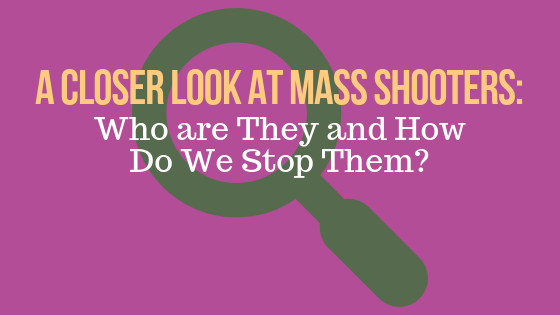How do you prevent a mass shooting? With the dramatic rise in mass shootings over the past few years, that question has been asked more and more. The FBI defines a mass shooting as an incident where four or more people, not including the suspect, perish in one or more public locations within 24 hours. During 2018, in the United States alone, there were 20 such shootings. Expanding the parameters to include shootings with three or less victims shows the number of shootings skyrocketing into the hundreds.
Which leads us back to the million dollar question; how do you prevent a mass shooting? How can we spare the families of hundreds of victims the heartbreak of burying their loved one? While the answer may vary widely depending on who you ask, maybe the path to a solution starts at looking at what motivates the shooters in the first place. A study published in 2018 by Joel A. Capellan et al does just that.
Written By: Tara Luther, Promega
In their study, Capellan et al looked at the demographic, background, motivations, pre-event, and event-level behaviors of disgruntled employee, school, ideologically motivated, and rampage mass public shooters in the United States from 1966-2017. The researchers excluded shootings where the suspect’s families were their primary target and felony-related shootings related to other criminal activity. They did, however, include incidents where there were less than four victims killed if the intent was to harm more than four people. Their hope was that examining the commonalities and differences among these shooters could lead to policies and prevention strategies that would be tailored for each type.
They defined disgruntled employee shooters to be those who were focused on their current or former place of work, and also included partners, co-owners, or investors in this category. School shooters are those who target their current or former schools and it must have occurred on school grounds. Ideologically motivated shooters would consist of extremists such as jihadists, far-right individuals, or Black Nationalism members). To determine if a shooter qualified as ideologically motivated, Capellan et al utilized the Extremist Crime Dataset’s (ECDB) Strenght of Association measurement protocol, which ranges from 0-4, with four being the highest level of certainty that the attack was ideologically motivated. Those scoring higher than a 1 were included in this category. Rampage shooters represent an “other” category for mass shooters who don’t belong in any of the previous three.
In order to examine shootings fitting their criteria, Capellan et al used open-source, searchable, electronic data documents freely available to the public, (newspaper articles or government documents), online search engines, social media accounts, legal documents, blogs, and videos. The information gathered helped the researchers to piece together as complete a picture as possible of the attack, including information about the shooter’s motivation, any history of mental illness, pre-event behaviors, location, victim information, and the manner in which the attack was carried out.
Through their comparisons, Capellan et al found that rampage shootings were the most commonly occurring (36.1%), then disgruntled employees (29.8%), followed by school shootings (19.1%) and ideologically motivated shooters (14.7%). Throughout the years, the number of school shootings has declined, but rampage and disgruntled employee shootings have increased.
Though nearly all mass shootings are perpetrated by men (96%), school shooters tend to be the youngest with an average age of 20.6. Other categories saw the average offender age to be 37-39 years of age. School shootings also typically involve a white suspect (77%). In contrast, disgruntled employees have the highest share of African American shooters (32.6%), rampage shooters have the highest percentage of Latino perpetrators (14.7%), and ideologically motivated shooters have the highest share of offenders with Middle-Eastern descent (14.8%).
Their data also revealed that approximately 70% of shooters across all categories had a high school or lesser degree, have dysfunctional backgrounds, are single, unemployed, and have a history of substance abuse or mental illness.
In regards to motivation, the researchers found that school and rampage shooters were more likely to be driven by internal psychological processes and issues whereas, not surprisingly, disgruntled employees were most often motivated by revenge, and ideologically motivated shooters were motivated by extremist beliefs.
When it comes to preventing future attacks, restricting access to firearms is most likely to prevent school shootings, as 79.3% of school shooters acquired guns prior to the attack. They also recommend monitoring threats, especially when a disgruntled employee or ideologically motivated shooter makes the threat, as they are most likely to follow through on times, methods, and targets mentioned in the threat. School shooters and ideologically motivated shooters tend to follow through on threats made, but they also have a tendency of sharing these threats with friends and family, who are less likely to report them. Capellan et al recommend schools implement a public awareness campaign describing the warning signs of mass public shooters and the importance of reporting all threats. They say similar campaigns could be tailored to the other three types of shooters.
They also recommend ‘target hardening’ or measures taken to strengthen the security of a location, which could range from architectural design elements to additional security personnel. These measures should also be tailored to the type of shooter.
While preventing further mass shootings may seem like an impossible task, further examination into shooter characteristics and why shooters feel this is their best or only option as well as increased vigilance from the general public and law enforcement may help to save future lives.
Resources:
Disaggregating Mass Public Shootings: A Comparative Analysis of Disgruntled Employee, School, Ideologically motivated, and Rampage Shooters
Joel A. Capellan Ph.D., Joseph Johnson Ph.D., Jeremy R. Porter Ph.D., Christine Martin B.A.
First published: 18 December 2018, https://doi.org/10.1111/1556-4029.13985
WOULD YOU LIKE TO SEE MORE ARTICLES LIKE THIS? SUBSCRIBE TO THE ISHI BLOG BELOW!
SUBSCRIBE NOW!


